Step-by-Step Guide to AI Fly Tying: Crafting the Perfect Fly
Tying the Future: How to Create an AI-Designed Fly Pattern
Fly tying has always been a blend of tradition, skill, and creativity—passed down through generations of anglers who refine their patterns through trial and error. But what happens when we introduce artificial intelligence into the mix? Can a machine really design a better fly?
In this guide, we’ll explore how to tie a fly pattern generated by AI, merging classic techniques with cutting-edge technology. Whether you're a seasoned tier or just starting out, this step-by-step tutorial will help you craft a fly that’s not only visually stunning but also deadly effective on the water.
Why Use AI for Fly Design?
Fly fishing is an ever-evolving sport, and while traditional patterns have proven their worth, AI offers a fresh perspective. By analyzing countless successful fly designs and fish behavior data, AI can generate patterns optimized for specific conditions—sometimes even suggesting unconventional materials or color combinations that might never occur to a human tier.
The real question is: Could an AI-designed fly be so effective that it gets banned?
That’s the kind of pattern we’re after—one that looks natural, moves convincingly, and triggers aggressive strikes from even the wariest trout.
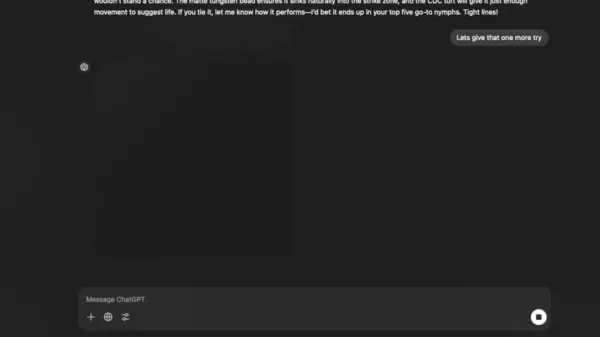
Materials You’ll Need
Before we dive into the tying process, let’s gather the essentials. The AI’s suggested pattern relies on a mix of natural and synthetic materials to create a lifelike, durable fly.
Core Materials:
- Hook: Curved nymph hook (size 12-16)
- Bead: Matte black (for weight and realism)
- Thread: Black (strong and reliable)
- Wire: Lead-free wire & gold wire (for ribbing and durability)
- CDC Feathers (Tan): Creates a lifelike tail
- Pheasant Tail Fibers: Adds texture and movement
- Lateral Flash: Subtle shimmer to mimic natural insects
- Thin Skin (Green): For a segmented body effect
- Ostrich Herl (Brown): Builds body bulk
- Peacock Herl: Adds natural iridescence
- Mallard Flank Feathers: Enhances the wet-fly profile
- Grizzly Saddle Hackle: For added wing definition
Essential Tools:
- Vise: Keeps your hook steady
- Bobbin Holder: For smooth thread control
- Fine-Tipped Scissors: Precision trimming
- Whip Finisher: Secures your thread neatly
- Hackle Pliers: Helps wrap feathers evenly
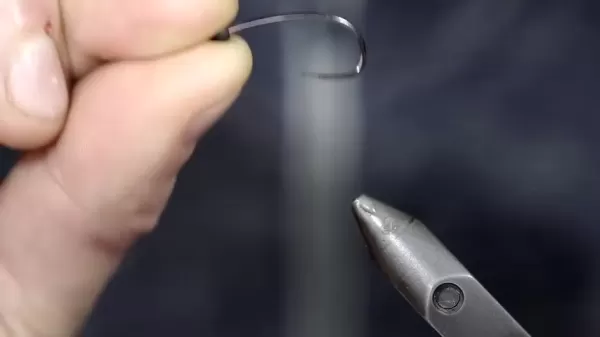
Step-by-Step Tying Guide
1. Setting the Foundation: Bead & Thread
Start by sliding a matte black bead onto your curved nymph hook. Secure it in place with tight wraps of black thread behind the bead. Snip any excess thread for a clean base.

2. Adding Weight & Stability: Lead-Free Wire
Wrap lead-free wire around the hook shank to reinforce the bead’s position and add a bit of sink rate. Trim the excess and ensure a smooth, streamlined profile.
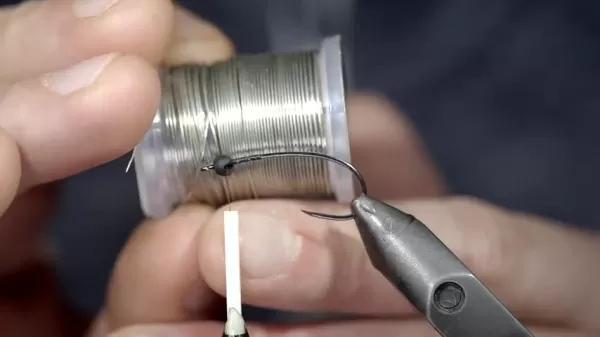
3. Creating a Hotspot: Gold Wire Ribbing
Gold wire isn’t just for looks—it acts as a trigger point for trout. Secure a small section near the bend of the hook and wrap it forward in tight spirals.
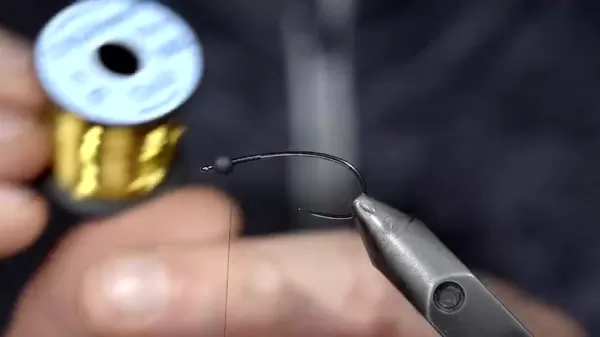
4. Building the Tail: CDC & Pheasant Tail
Blend tan CDC feathers with pheasant tail fibers for a natural, flowing tail. Secure them at the hook’s bend, ensuring they splay outward for lifelike movement.
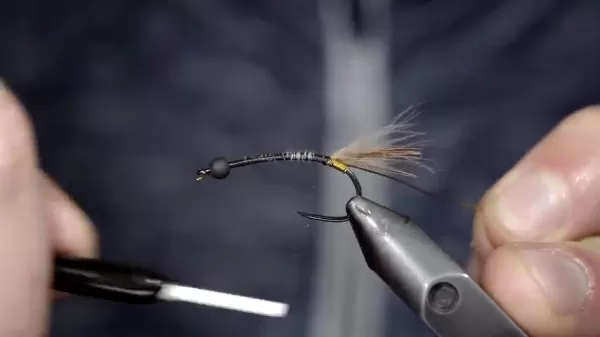
5. Adding Flash: Lateral Lace
A touch of lateral flash mimics the reflective properties of real insects. Tie it in alongside the tail for subtle underwater sparkle.
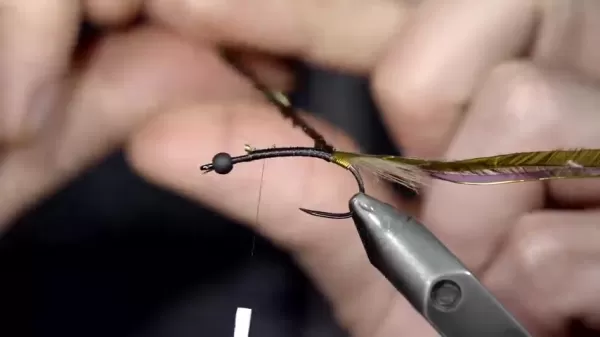
6. Crafting the Body: Thin Skin & Ostrich Herl
Loop green thin skin over the hook to create segmentation, then wrap brown ostrich herl forward to bulk up the body. Follow with peacock herl for extra shimmer.
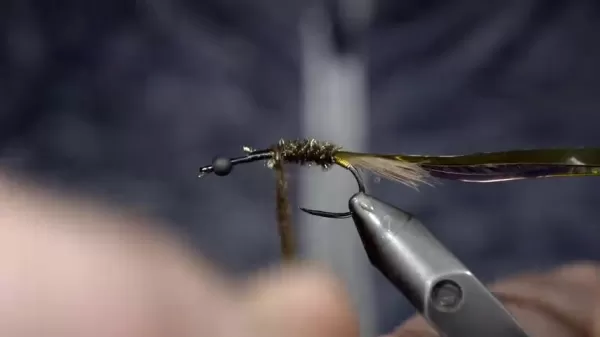
7. Finishing Touches: Wing & Head
Add mallard flank and grizzly saddle hackle for wing definition. Once everything is secured, build a neat thread head and whip-finish for durability.
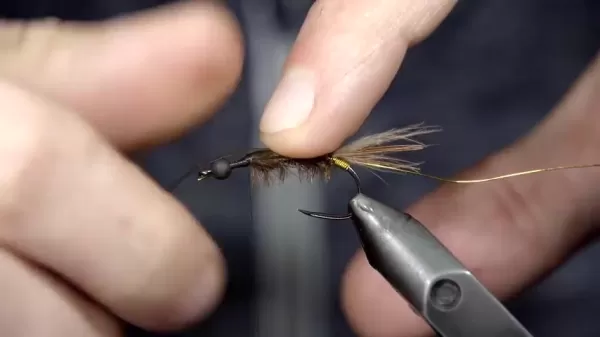
Pros & Cons of the AI Fly
✔️ Pros:
- Highly realistic – Mimics natural insect movement
- Durable construction – Built to last multiple fish
- Versatile – Works in various trout waters
- Innovative design – AI-driven efficiency
❌ Cons:
- Material-heavy – Some components may be hard to find
- Time-consuming – Not the fastest tie for beginners
- Effectiveness varies – Depends on local trout behavior
FAQs
Q: Can I substitute materials if I don’t have the exact ones?
Absolutely! Synthetic dubbing can replace natural fibers, and different wire colors can be used—just keep the overall profile similar.
Q: Why use a curved nymph hook?
The curve mimics the natural posture of aquatic insects, making the fly more convincing.
Q: Does the bead really help?
Yes! It adds weight for deeper presentations and enhances the fly’s sink rate.
Final Thoughts
AI might not replace the art of fly tying, but it certainly pushes the boundaries of what’s possible. This pattern blends tradition with innovation, resulting in a fly that’s both beautiful and effective. Give it a try—you might just find your new secret weapon on the water.
Tight lines! 🎣
Related article
 Master Emerald Kaizo Nuzlocke: Ultimate Survival & Strategy Guide
Emerald Kaizo stands as one of the most formidable Pokémon ROM hacks ever conceived. While attempting a Nuzlocke run exponentially increases the challenge, victory remains achievable through meticulous planning and strategic execution. This definitiv
Master Emerald Kaizo Nuzlocke: Ultimate Survival & Strategy Guide
Emerald Kaizo stands as one of the most formidable Pokémon ROM hacks ever conceived. While attempting a Nuzlocke run exponentially increases the challenge, victory remains achievable through meticulous planning and strategic execution. This definitiv
 AI-Powered Cover Letters: Expert Guide for Journal Submissions
In today's competitive academic publishing environment, crafting an effective cover letter can make the crucial difference in your manuscript's acceptance. Discover how AI-powered tools like ChatGPT can streamline this essential task, helping you cre
AI-Powered Cover Letters: Expert Guide for Journal Submissions
In today's competitive academic publishing environment, crafting an effective cover letter can make the crucial difference in your manuscript's acceptance. Discover how AI-powered tools like ChatGPT can streamline this essential task, helping you cre
 US to Sanction Foreign Officials Over Social Media Regulations
US Takes Stand Against Global Digital Content Regulations
The State Department issued a sharp diplomatic rebuke this week targeting European digital governance policies, signaling escalating tensions over control of online platforms. Secretary Marco
Comments (3)
0/200
US to Sanction Foreign Officials Over Social Media Regulations
US Takes Stand Against Global Digital Content Regulations
The State Department issued a sharp diplomatic rebuke this week targeting European digital governance policies, signaling escalating tensions over control of online platforms. Secretary Marco
Comments (3)
0/200
![NicholasCarter]() NicholasCarter
NicholasCarter
 August 25, 2025 at 1:00:59 AM EDT
August 25, 2025 at 1:00:59 AM EDT
This AI fly tying guide is mind-blowing! I never thought tech could blend so well with such a traditional craft. Excited to try designing my own fly patterns with AI—hope it doesn’t outfish me! 🎣


 0
0
![WalterBaker]() WalterBaker
WalterBaker
 August 17, 2025 at 9:00:59 AM EDT
August 17, 2025 at 9:00:59 AM EDT
Whoa, AI designing fishing flies? That's wild! I wonder if it can outsmart the trout like my grandpa's old patterns did. 🤔 Cool read!


 0
0
![RalphThomas]() RalphThomas
RalphThomas
 July 27, 2025 at 9:20:21 PM EDT
July 27, 2025 at 9:20:21 PM EDT
This AI fly tying guide is wild! I never thought tech could jazz up something as old-school as fishing. The step-by-step is super clear, but I’m curious—can AI really outdo a seasoned angler’s intuition? 🤔 Excited to try this out next weekend!


 0
0
Tying the Future: How to Create an AI-Designed Fly Pattern
Fly tying has always been a blend of tradition, skill, and creativity—passed down through generations of anglers who refine their patterns through trial and error. But what happens when we introduce artificial intelligence into the mix? Can a machine really design a better fly?
In this guide, we’ll explore how to tie a fly pattern generated by AI, merging classic techniques with cutting-edge technology. Whether you're a seasoned tier or just starting out, this step-by-step tutorial will help you craft a fly that’s not only visually stunning but also deadly effective on the water.
Why Use AI for Fly Design?
Fly fishing is an ever-evolving sport, and while traditional patterns have proven their worth, AI offers a fresh perspective. By analyzing countless successful fly designs and fish behavior data, AI can generate patterns optimized for specific conditions—sometimes even suggesting unconventional materials or color combinations that might never occur to a human tier.
The real question is: Could an AI-designed fly be so effective that it gets banned?
That’s the kind of pattern we’re after—one that looks natural, moves convincingly, and triggers aggressive strikes from even the wariest trout.

Materials You’ll Need
Before we dive into the tying process, let’s gather the essentials. The AI’s suggested pattern relies on a mix of natural and synthetic materials to create a lifelike, durable fly.
Core Materials:
- Hook: Curved nymph hook (size 12-16)
- Bead: Matte black (for weight and realism)
- Thread: Black (strong and reliable)
- Wire: Lead-free wire & gold wire (for ribbing and durability)
- CDC Feathers (Tan): Creates a lifelike tail
- Pheasant Tail Fibers: Adds texture and movement
- Lateral Flash: Subtle shimmer to mimic natural insects
- Thin Skin (Green): For a segmented body effect
- Ostrich Herl (Brown): Builds body bulk
- Peacock Herl: Adds natural iridescence
- Mallard Flank Feathers: Enhances the wet-fly profile
- Grizzly Saddle Hackle: For added wing definition
Essential Tools:
- Vise: Keeps your hook steady
- Bobbin Holder: For smooth thread control
- Fine-Tipped Scissors: Precision trimming
- Whip Finisher: Secures your thread neatly
- Hackle Pliers: Helps wrap feathers evenly

Step-by-Step Tying Guide
1. Setting the Foundation: Bead & Thread
Start by sliding a matte black bead onto your curved nymph hook. Secure it in place with tight wraps of black thread behind the bead. Snip any excess thread for a clean base.

2. Adding Weight & Stability: Lead-Free Wire
Wrap lead-free wire around the hook shank to reinforce the bead’s position and add a bit of sink rate. Trim the excess and ensure a smooth, streamlined profile.

3. Creating a Hotspot: Gold Wire Ribbing
Gold wire isn’t just for looks—it acts as a trigger point for trout. Secure a small section near the bend of the hook and wrap it forward in tight spirals.

4. Building the Tail: CDC & Pheasant Tail
Blend tan CDC feathers with pheasant tail fibers for a natural, flowing tail. Secure them at the hook’s bend, ensuring they splay outward for lifelike movement.

5. Adding Flash: Lateral Lace
A touch of lateral flash mimics the reflective properties of real insects. Tie it in alongside the tail for subtle underwater sparkle.

6. Crafting the Body: Thin Skin & Ostrich Herl
Loop green thin skin over the hook to create segmentation, then wrap brown ostrich herl forward to bulk up the body. Follow with peacock herl for extra shimmer.

7. Finishing Touches: Wing & Head
Add mallard flank and grizzly saddle hackle for wing definition. Once everything is secured, build a neat thread head and whip-finish for durability.

Pros & Cons of the AI Fly
✔️ Pros:
- Highly realistic – Mimics natural insect movement
- Durable construction – Built to last multiple fish
- Versatile – Works in various trout waters
- Innovative design – AI-driven efficiency
❌ Cons:
- Material-heavy – Some components may be hard to find
- Time-consuming – Not the fastest tie for beginners
- Effectiveness varies – Depends on local trout behavior
FAQs
Q: Can I substitute materials if I don’t have the exact ones?
Absolutely! Synthetic dubbing can replace natural fibers, and different wire colors can be used—just keep the overall profile similar.
Q: Why use a curved nymph hook?
The curve mimics the natural posture of aquatic insects, making the fly more convincing.
Q: Does the bead really help?
Yes! It adds weight for deeper presentations and enhances the fly’s sink rate.
Final Thoughts
AI might not replace the art of fly tying, but it certainly pushes the boundaries of what’s possible. This pattern blends tradition with innovation, resulting in a fly that’s both beautiful and effective. Give it a try—you might just find your new secret weapon on the water.
Tight lines! 🎣
 Master Emerald Kaizo Nuzlocke: Ultimate Survival & Strategy Guide
Emerald Kaizo stands as one of the most formidable Pokémon ROM hacks ever conceived. While attempting a Nuzlocke run exponentially increases the challenge, victory remains achievable through meticulous planning and strategic execution. This definitiv
Master Emerald Kaizo Nuzlocke: Ultimate Survival & Strategy Guide
Emerald Kaizo stands as one of the most formidable Pokémon ROM hacks ever conceived. While attempting a Nuzlocke run exponentially increases the challenge, victory remains achievable through meticulous planning and strategic execution. This definitiv
 AI-Powered Cover Letters: Expert Guide for Journal Submissions
In today's competitive academic publishing environment, crafting an effective cover letter can make the crucial difference in your manuscript's acceptance. Discover how AI-powered tools like ChatGPT can streamline this essential task, helping you cre
AI-Powered Cover Letters: Expert Guide for Journal Submissions
In today's competitive academic publishing environment, crafting an effective cover letter can make the crucial difference in your manuscript's acceptance. Discover how AI-powered tools like ChatGPT can streamline this essential task, helping you cre
 US to Sanction Foreign Officials Over Social Media Regulations
US Takes Stand Against Global Digital Content Regulations
The State Department issued a sharp diplomatic rebuke this week targeting European digital governance policies, signaling escalating tensions over control of online platforms. Secretary Marco
US to Sanction Foreign Officials Over Social Media Regulations
US Takes Stand Against Global Digital Content Regulations
The State Department issued a sharp diplomatic rebuke this week targeting European digital governance policies, signaling escalating tensions over control of online platforms. Secretary Marco
 August 25, 2025 at 1:00:59 AM EDT
August 25, 2025 at 1:00:59 AM EDT
This AI fly tying guide is mind-blowing! I never thought tech could blend so well with such a traditional craft. Excited to try designing my own fly patterns with AI—hope it doesn’t outfish me! 🎣


 0
0
 August 17, 2025 at 9:00:59 AM EDT
August 17, 2025 at 9:00:59 AM EDT
Whoa, AI designing fishing flies? That's wild! I wonder if it can outsmart the trout like my grandpa's old patterns did. 🤔 Cool read!


 0
0
 July 27, 2025 at 9:20:21 PM EDT
July 27, 2025 at 9:20:21 PM EDT
This AI fly tying guide is wild! I never thought tech could jazz up something as old-school as fishing. The step-by-step is super clear, but I’m curious—can AI really outdo a seasoned angler’s intuition? 🤔 Excited to try this out next weekend!


 0
0





























